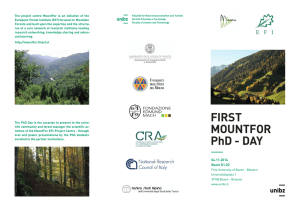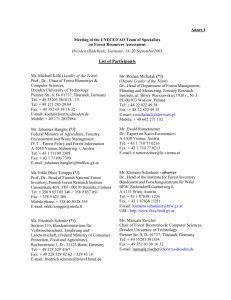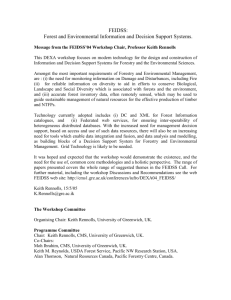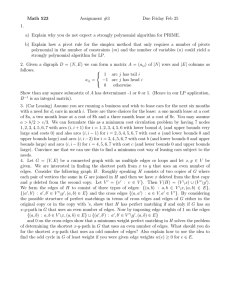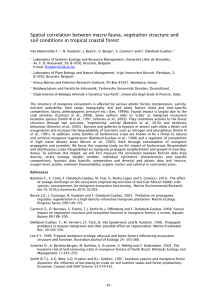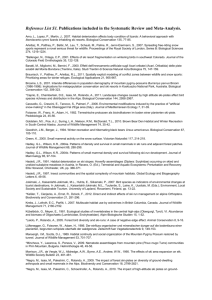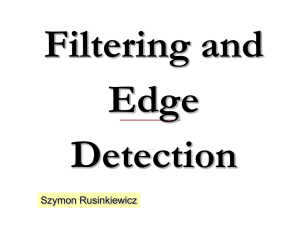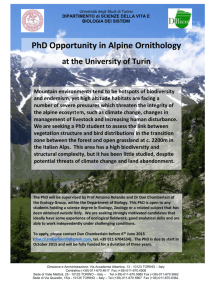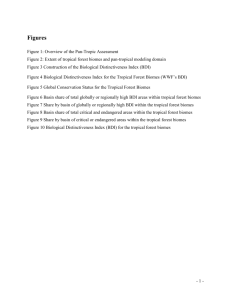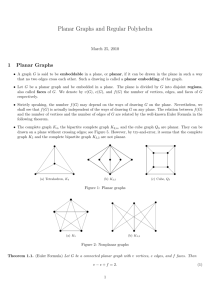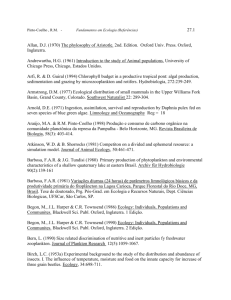Proposal for workshop on quantitative measurement of
advertisement
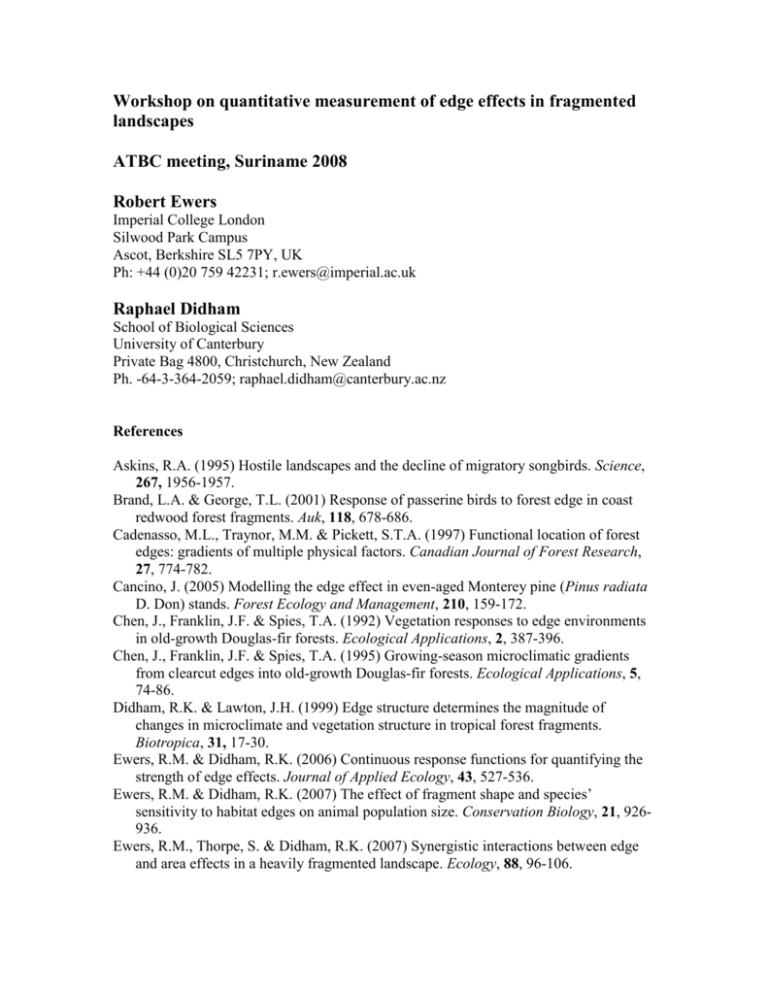
Workshop on quantitative measurement of edge effects in fragmented landscapes ATBC meeting, Suriname 2008 Robert Ewers Imperial College London Silwood Park Campus Ascot, Berkshire SL5 7PY, UK Ph: +44 (0)20 759 42231; r.ewers@imperial.ac.uk Raphael Didham School of Biological Sciences University of Canterbury Private Bag 4800, Christchurch, New Zealand Ph. -64-3-364-2059; raphael.didham@canterbury.ac.nz References Askins, R.A. (1995) Hostile landscapes and the decline of migratory songbirds. Science, 267, 1956-1957. Brand, L.A. & George, T.L. (2001) Response of passerine birds to forest edge in coast redwood forest fragments. Auk, 118, 678-686. Cadenasso, M.L., Traynor, M.M. & Pickett, S.T.A. (1997) Functional location of forest edges: gradients of multiple physical factors. Canadian Journal of Forest Research, 27, 774-782. Cancino, J. (2005) Modelling the edge effect in even-aged Monterey pine (Pinus radiata D. Don) stands. Forest Ecology and Management, 210, 159-172. Chen, J., Franklin, J.F. & Spies, T.A. (1992) Vegetation responses to edge environments in old-growth Douglas-fir forests. Ecological Applications, 2, 387-396. Chen, J., Franklin, J.F. & Spies, T.A. (1995) Growing-season microclimatic gradients from clearcut edges into old-growth Douglas-fir forests. Ecological Applications, 5, 74-86. Didham, R.K. & Lawton, J.H. (1999) Edge structure determines the magnitude of changes in microclimate and vegetation structure in tropical forest fragments. Biotropica, 31, 17-30. Ewers, R.M. & Didham, R.K. (2006) Continuous response functions for quantifying the strength of edge effects. Journal of Applied Ecology, 43, 527-536. Ewers, R.M. & Didham, R.K. (2007) The effect of fragment shape and species’ sensitivity to habitat edges on animal population size. Conservation Biology, 21, 926936. Ewers, R.M., Thorpe, S. & Didham, R.K. (2007) Synergistic interactions between edge and area effects in a heavily fragmented landscape. Ecology, 88, 96-106. Fagan, W.F., Cantrell, R.S. & Cosner, C. (1999) How habitat edges change species interactions. American Naturalist, 153, 165-182. Fraver, S. (1994) Vegetation responses along edge-to-interior gradients in the mixed hardwood forests of the Roanoke River basin, North Carolina. Conservation Biology, 8, 822-832. Harper, K.A. & MacDonald, S.E. (2001) Structure and composition of riparian boreal forest: new methods for analyzing edge influence. Ecoogy, 82, 649-659. Harper, K.A., MacDonald, S.E., Burton, P.J., Chen, J., Brosofske, K.D., Saunders, S.C., Euskirchen, E.S., Roberts, D., Jaiteh, M.S. & Esseen, P.-A. (2005) Edge influence on forest structure and composition in fragmented landscapes. Conservation Biology, 19, 768-782. Huxel, G.R. & McCann, K.S. (1998) Food web stability: the influence of trophic flows across habitats. American Naturalist, 152, 460-469. Hylander, K. (2005) Aspect modifies the magnitude of edge effects on bryophyte growth in boreal forests. Journal of Applied Ecology, 42, 518-525. Laurance, W.F., Ferreira, L.V., Rankin-de Merona, J.M. & Laurance, S.G. (1998) Rain forest fragmentation and the dynamics of Amazonian tree communities. Ecology, 79, 2032-2040. Laurance, W.F., Lovejoy, T.E., Vasconcelos, H.L., Bruna, E.M., Didham, R.K., Stouffer, P.C., Gascon, C., Bierregaard, R.O., Laurance, S.G. & Sampaio, E. (2002) Ecosystem decay of Amazonian forest fragments: a 22-year investigation. Conservation Biology, 16, 605-618. Laurance, W.F. & Yensen, E. (1991) Predicting the impacts of edge effects in fragmented habitats. Biological Conservation, 55, 77-92. Mancke, R.G. & Gavin, T.A. (2000) Breeding bird density in woodlots: effects of depth and buildings at the edges. Ecological Applications, 10, 598-611. Murcia, C. (1995) Edge effects in fragmented forests: implications for conservation. Trends in Ecology and Evolution, 10, 58-62. Ries, L., Fletcher, R.J.J., Battin, J. & Sisk, T.D. (2004) Ecological responses to habitat edges: mechanisms, models and variability explained. Annual Review of Ecology, Evolution and Systematics, 35, 491-522. Sisk, T.D. & Battin, J. (2002) Habitat edges and avian ecology: geographic patterns and insights for western landscapes. Studies in Avian Biology, 25, 30-48. Sisk, T.D., Haddad, N.M. & Ehrlich, P.R. (1997) Bird assemblages in patchy woodlands: Modeling the effects of edge and matrix habitats. Ecological Applications, 7, 11701180. Temple, S.A. (1986) Predicting impacts of habitat fragmentation on forest birds: a comparison of two models. Modelling habitat relationships of terrestrial vertebrates (eds J. Verner & M.L. Morrison), pp. 301-304. University of Wisconsin Press. Toms, J.D. & Lesperance, M.L. (2003) Piecewise regression: a tool for identifying ecological thresholds. Ecology, 84, 2034-2041. Wiens, J.A. (1992) Ecological flows across landscape boundaries: a conceptual overview. Landscape boundaries: consequences for biotic diversity and ecological flows (eds A.J. Hansen & F. di Castri), pp. 217-235. Springer-Verlag, New York. Wiens, J.A., Crawford, C.S. & Gosz, J.R. (1985) Boundary dynamics: a conceptual framework for studying landscape ecosystems. Oikos, 45, 421-427. Yahner, R.H. (1988) Changes in wildlife communities near edges. Conservation Biology, 2, 333-339. Zheng, D. & Chen, J. (2000) Edge effects in fragmented landscapes: a generic model for delineating area of edge influences (D-AEI). Ecological Modelling, 132, 175-190.
